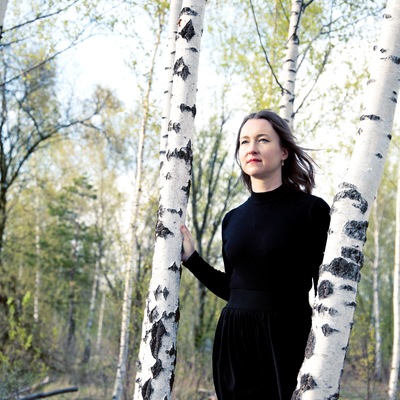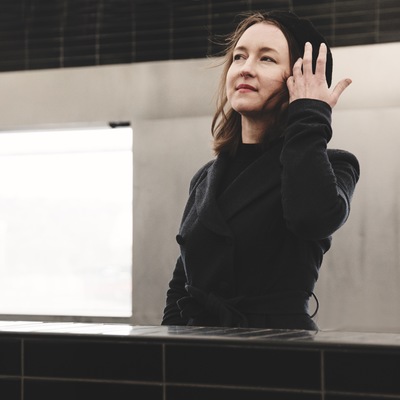When she is not on the road presenting her music, which is played by the most important contemporary ensembles and large symphony orchestras, Lisa Streich lives with her family on the Swedish island of Gotland. She uses the most modern compositional techniques to create a universal musical language that speaks directly to the audience and captures today’s zeitgeist without being ingratiating. Annelis Berger tries to find out how she manages in a conversation.

Annelis Berger
Contrasts, over and over again: sharp whip beats penetrate the ear, and in the gaps – these horrible gaps between the beats – hover strangely enraptured pianissimo chords, where one does not know whether the ear is deceiving itself or the orchestra musicians are softly singing along. One sits there amazed and immersed in a surprising musical language that somehow “makes sense”, although complex and multi-layered. Segel is the title of Lisa Streich’s piece, which premiered at the Lucerne Festival in 2018.
It is my first contact with the Swedish composer’s music. Later, I realised that this musical language is typical of Lisa Streich’s works: they surprise, and at the same time speak directly to the listener. One does not feel excluded, not even at first hearing. There is no hermetic superstructure that one first has to figure out to find access to the music, despite the fact that each of the pieces is the result of very elaborate intellectual, artistic and technical work.
In Segel from 2017, Lisa Streich used a “spectral tonality” for the first time.
Lisa Streich was born in Sweden in 1985, she trained as organist and later studied composition in Berlin, Stockholm, Salzburg, Paris and Cologne. She avoids the spotlight, the stage is not her thing. But in the gallery, alone at the organ, this “breathing creature that doesn’t belong to you and that smells different in every church”, that’s where she feels comfortable. The same goes for composing at home on the island of Gotland, which lies on the Baltic Sea between the Baltic States and Sweden and where, close to the sea and in the midst of a picturesque landscape, she alternately occupies herself with family fife and composition. This also includes tinkering, handicrafts, building devices. At some point, Lisa Streich started to incorporate electronics into her music, small machines that she builds in an old shed next to her house: She soldered, built, assembled and then, for example, in the piece Pietà for motorised cello and ensemble, created an almost mechanical sound that is so exciting precisely because it becomes universal through mechanical anonymity.
Pietà ends quietly. All of Lisa Streich’s pieces, without exception, end in piano. During the interview, she tells me that, until now, she has forbidden herself to allow loud endings; a fortissimo finale feels like plagiarism to her, like a worn out, cheap effect. Such statements are typical of the Swedish composer, who speaks perfect German. She has a high, almost moral claim to be honest with her music. That is why a statement by the Greek composer Georges Aperghis, according to which an artist must be a good liar, still concerns her today. Somehow, she can see what he means and it makes sense, but it doesn’t work for her, she says.
No, that doesn’t work for Lisa. Her music is instead distinguished by a playful spirituality, one not achieved through artifice, but through authenticity, honesty, not a moralistic sourness, but a sensual truthfulness. How she achieves this remains a secret, but, she says, she perhaps captures a certain feeling of the times with her music, which corresponds to today’s audience. Naturally, one does not have control over this. But sometimes something creeps into a work that hits the core of our time.

So what are the most important compositional elements that make Lisa Streich’s music so authentic, exciting and “current”?
Spectral tonality and electronic sounds
There is, for example, the so-called spectral tonality, which Lisa Streich used for the first time in the above-mentioned work “Segel”. To create such floating chords, she looks for recordings of amateur choirs, which by their very nature are not perfect. She takes chords from these intonationally not quite clean recordings and makes a spectral analysis of them. She then works with this spectrogram in order to create a microtonal or “spectral tonality”. Lisa Streich says that she loves tonal music, but that through frequent playing and listening she gradually felt nothing more about it. On the other hand, when she listens to amateur choirs that don’t have a completely clean intonation, she experiences tonality in a new way. In other words, when familiar chords are a little off, you can experience major and minor anew.
Another compositional mean in Lisa Streich’s music is electronic sounds, which she creates by attaching small devices to the instrument. This creates a very unique, soulful, mechanical atmosphere – often in contrast with sharp ensemble sounds that collide with these mechanical “Olimpia worlds” (E.T.A. Hoffmann).
Echoes of Roman polychoralism
There is also an affinity with the human voice and choral traditions that runs through Lisa Streich’s oeuvre. For example, in the wonderful work Stabat for 32 voices and four choirs, written in Rome during Streich’s stay at Villa Massimo. It is one of her longest pieces and inspired by Roman polychoral music, which, unlike the Venetian, is hardly cultivated any more, as it is very expensive to perform this 400-year-old, multi-choral music. In those days, boys sang on the balconies and even in the dome of St. Peter’s, connected to the conductor only by hatches. In the church of S. Giovanni in Laterano, for example, where the choral work was first performed, there are twelve balconies. This many-choir system was originally used to create a kind of unplugged Dolby Surround sound system, which fascinated Lisa Streich and she tried to bring this sound into the 21st century in a four-choir work. The resulting piece is a kind of meditation for choir, suggesting a vast landscape, or a timeless and spaceless level into which one can fall without landing softly nor hard. One simply IS.
32 voices distributed over four choirs can be heard in Stabat by Lisa Streich from 2017. Here she translates the 400-year-old Roman polychoral into the 21st century.
Lisa Streich answers the question about religious content of such works, which already refer to an ecclesiastical tradition from their title, hesitantly. Yes, religion used to play an important role in her life. Less so today, but it is still important. However, it is less linked to a specific religion. “I am sure that there is a world that is invisible, but stronger and bigger than our visible one. Music, too, allows us to experience or feel things that are perhaps not of this world at all.”
In fact, Streich’s music offers the possibility of spiritual openings, if one allows oneself to be drawn into it. Perhaps this is precisely what appeals in the composer’s work, not the programme, but an underlying current that one consciously or unconsciously perceives.
Annelis Berger
On Saturday, October 8, at 7:3pm, the Collegium Novum Zurich will premiere her piece OFELIA at Zurich Tonhalle.
broadcasts SRF 2 Kultur:
Musik unserer Zeit, 12.10.22, 20h / 15.10.22, 21h: Im Innern der Orgel: Lisa Streich, composer and organist, author Annelis Berger
Neo-Profiles: Lisa Streich, Collegium Novum Zürich,

